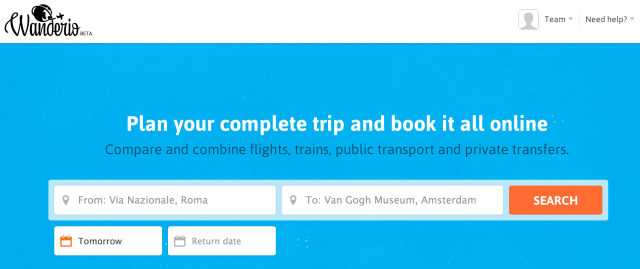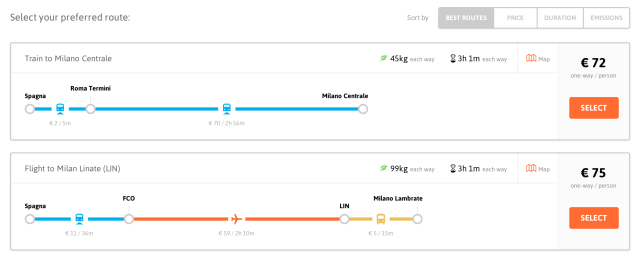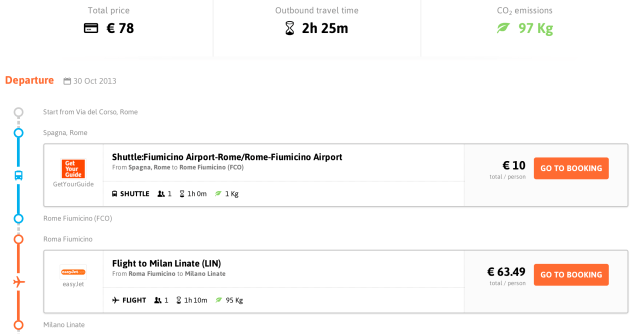Twenty-two sites. That’s the average number a traveller visits before booking a big trip. But Wanderio wants to be your one and only. The Italian startup lets you enter any two addresses worldwide, and it shows the cheapest, most convenient combination of planes, trains, and automobiles to get you door-to-door. Today Wanderio comes out of private beta and launches publicly at TechCrunch Disrupt Berlin.
Booking travel can induce decision paralysis. With so many permutations of ways to get from place to place, it can be tough to finalize plans with confidence. Is this the cheapest way? With the shortest total travel time? With the fewest transfers?

Wanderio’s co-founder Disheng Qiu felt this pain himself. He was living in Rome while his girlfriend lived in Amsterdam. He longed to see her…without going bankrupt or spending his life on the move.
There were sites comparing flights like Hipmunk, or for booking trains, or for finding taxis and shuttles, but none that brought them all together. In Europe especially, flights can be cheap, but ground transport is expensive, and with multiple airports in major cities, the distance from touchdown to final destination can vary widely.
Lisheng needed Wanderio, so the star developer and computer science PhD began building it with his co-founders CEO Matteo Colò, a management Masters, and CTO Luca Rossi, another CS PhD. The 8-person team has impressively bootstrapped the company for two years so far, but is now looking to close a round of about €150,000.
Wanderio launched its private beta in June, but today opens the service to everyone. It works worldwide, but has the deepest options indexed for European travel.

The Wanderio interface will be familiar to anyone who’s used Hipmunk or Kayak, but rather than entering your start and end city or airport, you can enter exact addresses. Wanderio crunches all the travel combos and shows you the best routes as easy-to-understand visual timelines. Each leg of the journey is color-coded and displays the travel time and price. It’s built web first, but has a tablet-optimized mobile site with plans for native apps
Wanderio also lets you filter results by price, duration, or even CO2 emissions for the eco-conscious. You pick a route, then lock in each leg’s specifics. When you’re ready to book, Wanderio sends you to the airline, train, and taxi/shuttle sites to pay. That last part is a bit of a hassle, but the team eventually hopes to strike integrations with its partners so you can buy tickets straight from Wanderio.

The startup earns money from referral fees. On flights it’s just a tiny 1%, for trains it’s 5% to 7%, but on ground transportation it can be as high as 10% or 15%.
Helping people book their taxis, shuttles, and limos to and from the airport or train station will be Wanderio’s cash cow. “Those are services without much exposure on the Internet” so they’re willing to pay high referral fees, Wanderio CTO Luca Rossi tells me. Long-term, Wanderio is interested in finding people accommodations and events to go to on their trip, from museums to concerts.
But in the meantime, it will have to survive competition from Waymate, GoEuro, and more. Wanderio hopes to win by focusing on the door-to-door experience including ground connections, but so does fellow journey planner RouteRank. There are also new startups like Vamo from former Facebooker Ari Steinberg to contend with. Wanderio doesn’t have a strong viral loop right now. That could make it growth tough, along with ample competition,
They’re all in it for the same reason, though. Wanderio‘s Rossi proclaims, “Travel is one of the best experiences in people’s lives. It connects people, makes you interact with other cultures. We’re helping people have a more pleasant experience as a whole. Technology can do all the work on their behalf. You should enjoy your travel and that’s it.”
[gallery ids="906723,906724,906725,906726,906727,906728"]
Wanderio presented today in the TechCrunch Disrupt Berlin 2013 Battlefield. Here’s a recap of its Q&A with the judges:
It’s obvious how to get from one big city to another, and people rarely need to travel between distant small villages. Why is this necessary? If you don’t have an effective way to compare the services, you end up paying much more, even if you think your route is obvious.
Competitor GoEuro has raised a lot of money. How are you different? We have a different focus on transfers. We’re working on repository of this data. We currently have 20,000 transfer services offered. We get you from door to door.
Do you need to do the flight search at all? Or can you just be a way to compare how to get back and forth from the airport? “We’re addressing the pain of travel” and it wouldn’t make sense to make people go to another site to compare flights.